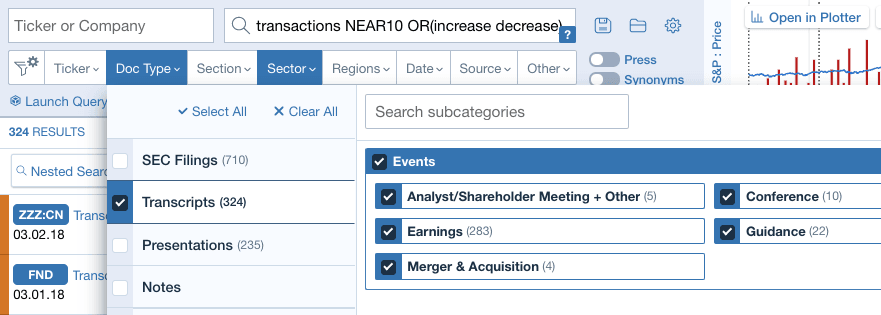If you’ve ever tried finding details of revenue growth drivers for companies in the restaurant or retail space, you may have found it difficult. That’s because this information is not broken down in GAAP metrics or other standardized financial reporting, but it tends to be discussed in quarterly earnings calls.
Check out our H2 hedge fund letters here.
Normally, an analyst would need to listen to the call or dig through the transcript looking for these numbers, but using Sentieo they can find it with a simple search and save it for later use.
There are components to retail sales growth that are typically discussed on earnings calls:
(1) Opening more stores and (2) comparable store sales, which breaks down into:
a. Selling more at existing stores (more transactions)
b. Increased pricing per unit (higher average ticket size)
We opened up DocSearch and entered the following query: transactions NEAR10 OR(increase decrease). This brings up references to increasing or decreasing transaction volume along with synonyms. We used NEAR10 because the word transaction might be before or after the indicator of change and might not be right next to it.
We narrowed down our search to mentions within earnings call transcripts:
Then we also filtered down by sector:

We got some interesting results. We found Floor and Decor Holdings (FND), whose team had their Q4 2017 earnings call a couple weeks ago.

Their call included the following mentions of transaction growth:

The quote above tells the following:
- Comparable store sales increased 16.2%
- Comp increase was driven largely by transaction growth (more transactions)
- Transactions increased for the year
- Average ticket size increased for the year (Prices increased)
It would have been difficult to have found this information outside of Sentieo, but we found it in seconds, with just a few clicks.
The Habit restaurant chain reported earnings on 2/28, and provided even more detail:

The comparable store sales decline of 1% was broken down into a transaction (traffic) decrease of 3% and an average transaction amount increase of 2%.
Searches like these can help you quickly isolate the important information you need and incorporate it into your research without spending extra time poring through documents.
Advanced User? Try These Queries for More Focused Results
If you’re an advanced Sentieo user, you can make this query even more precise by removing synonyms of increase and decrease that could produce false positives for this search. Normally, you would use quotes (“increase”) to search for exactly those words and exclude synonyms, however, this would also exclude stemming, which is helpful for this case. Stemming allows you to not only search for a specific keyword, but also to find the variations of the stem of the keyword. Using our example above, let’s say we want to search all variations of the word increase, such as increased, increasing, increases, but not improve, higher, or growth. To include these words, we’ll need to put carets in front of the main stem keyword instead of putting quotation marks around it (^^increase). These will turn off synonyms but leave on stemming.
The final search would be: transactions NEAR10 OR(^^increase ^^decrease)
Article by Rishi Mohnot, Sentieo






